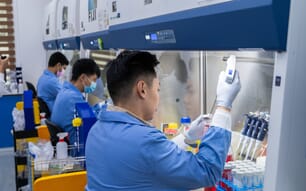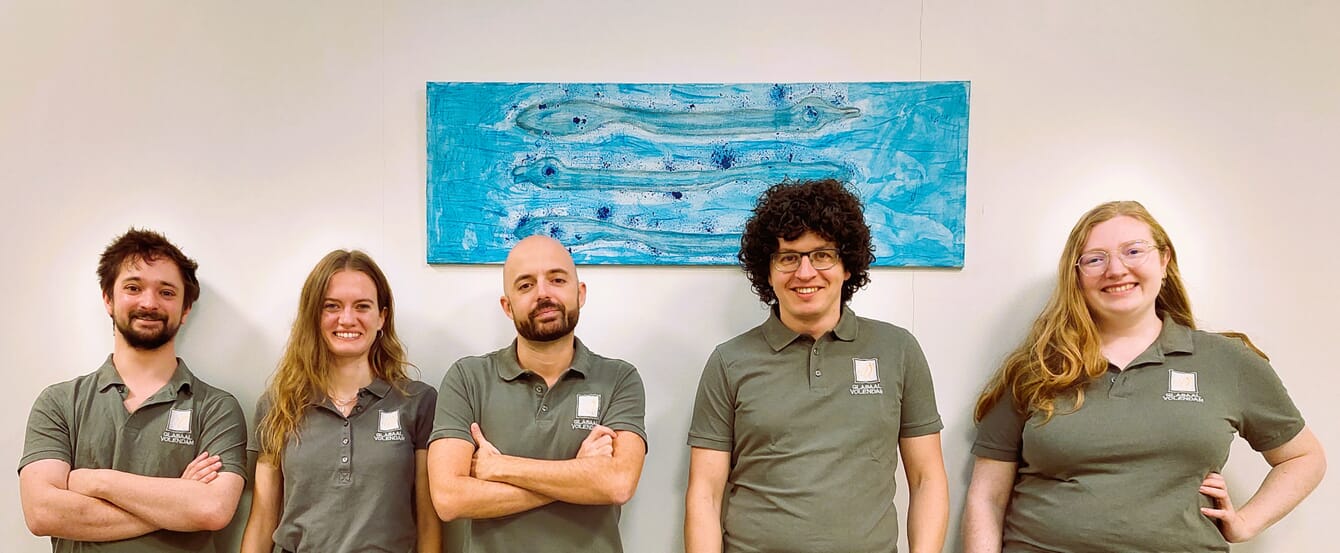
This group of researchers at the Dutch company are developing technologies and protocols to make the production of glass eels in aquaculture possible, in order to reduce pressure on wild eel populations © Glasaal Volendam
A challenging species
The European eel (Anguilla anguilla) has a very complicated and lengthy life cycle, making closed-cycle cultivation impossible so far. Thus, eel aquaculture is still fully dependent on wild-caught juveniles (glass eels).
The European eel population has declined by 90 percent in the past 50 years due to a combination of factors such as loss of habitat, pollution, diseases, obstruction of migration routes and fishing efforts. The International Council for the Exploration of the Sea (ICES) recently reported that the number of glass eels entering fresh water from the North Sea has drastically decreased in the last 40 years (Graph. 1). Therefore, the International Union for the Conservation of Nature (IUCN) has listed the European eel as “critically endangered”.
However, thanks to continuous effort by the eel industry and NGOs to improve the eel stocks, over the last years the stocks can be considered stable. Additional effort is required to allow the stocks to increase again.
While farming glass eels to market size eels is a well-established procedure, the life cycle of the European eel has still not been closed in captivity. However, the Dutch research institute Glasaal Volendam is one player that is keen to change this.
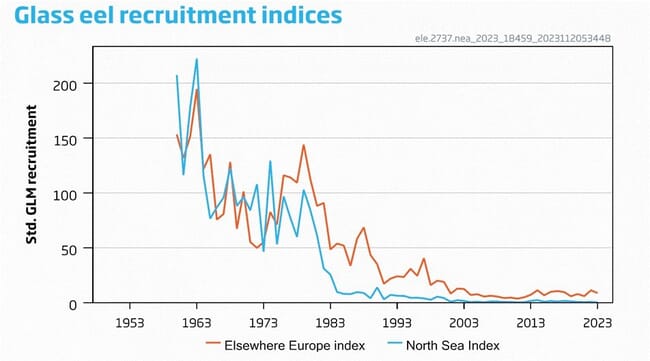
Recruitment indices of glass eels in Europe and North Sea from 1960 to 2023, from ICES (2023). European eel (Anguilla anguilla) throughout its natural range. ICES Advice: Recurrent Advice. © ICES Advice 2022
A special life cycle
The European eel is a catadromous fish species with a very peculiar life cycle and multiple life stages (Figure 1). Spawning occurs in the Sargasso Sea, where the larvae hatch from the eggs after two days. After about 6 weeks, these develop into leptocephalus larvae - a typical larval stage of the of the superorder Elopomorpha, characterised by very small heads and willow leaf-like transparent bodies. At this stage, they migrate to Europe across the Atlantic Ocean, probably drifting with the Gulf Stream.
Just before entering European continental waters, they metamorphose into glass eels. Once in freshwater, glass eels transform into elvers then yellow eels. They finally return to saltwater as silver eels and while maturing, they migrate back to the Sargasso Sea to spawn.
To date, no mature eels have been found in the Sargasso and the precise cues and conditions required for eels to mature, as well as for larvae to develop into leptocephalus and then into glass eels, are also unknown. As usually fish farmers refer to the natural conditions of a species when developing an initial rearing protocol, this knowledge gap makes it extremely challenging to develop protocols to rear eel larvae in captivity.
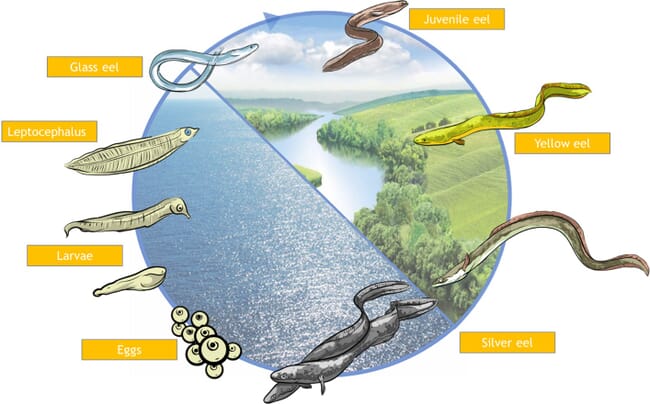
In 2023 Glasaal Volendam reached the leptocephalus stage and now the glass eel stage is only one step away © Glasaal Volendam
Hatchery technology development
At Glasaal Volendam our group of researchers is working hard to develop technologies and protocols to make the production of glass eels in aquaculture possible, in order to reduce pressure on wild eel populations.
Full-grown eels are matured in the research facility through artificial reproduction protocols to stimulate maturation of the gonads of the broodstock. In the past years a lot of attention has been given to broodstock management, in order to continuously produce high quality eel eggs. These are incubated for 48 hours and, after hatching, the larvae are transferred to larger rearing tanks.
Newly-hatched eel larvae don’t have a mouth, eyes or digestive system and during the first two weeks they survive by consuming their yolk sac while their eyes, mouth and anus are developing. When these organs are fully formed, then exogenous feeding starts. These first two weeks are a crucial moment in larval life and mortality can reach almost 100 percent if optimal rearing conditions are not met.
In the last two years, the research team managed to increase the average survival rate of the larvae in this period from an average of 3.8 percent to 21.7 percent, with some batches reaching over 50 percent. This huge improvement has allowed more larvae to enter the exogenous feeding stage and allowed the researchers to focus on the development of the right diet, on feeding methods and protocols to reach leptocephalus and glass eel stages.
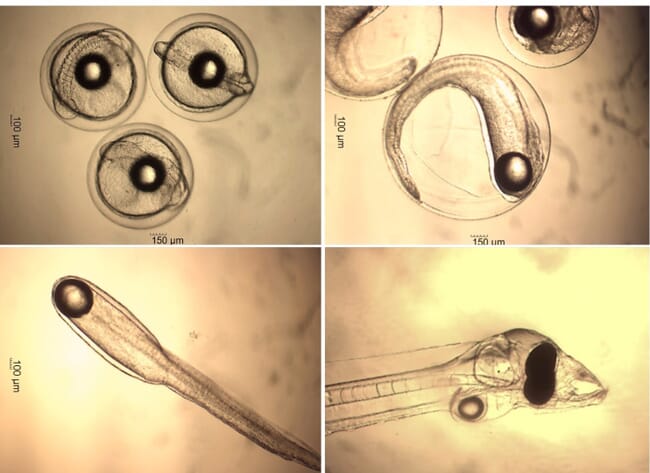
Upper left: embryo with spinal cord appearing at 36 hpf. Upper right: embryo at 43 hpf. Lower left: hatching larva at 48 hpf. Lower right: first feeding larvae at 14 dph, with residual yolk sac. © Glasaal Volendam
Improving survival and growth rates
Since eel larvae are characterised by a very peculiar and unique mouth morphology, feed ingestion has only been observed through the use of a slurry-type diet, inspired by protocols developed to rear Japanese eel larvae. Nevertheless, there are many other parameters affecting larval feeding behaviour, growth and survival. These include diet composition and size, feeding regime, amount of food and moment of the onset of feeding.
Furthermore, environmental parameters such as water quality, temperature, salinity and light intensity vastly influence ingestion and survival. With every batch of larvae, the team runs different feeding experiments on one or more parameter, in order to improve survival and growth rates to achieve the leptocephalus stage (figure 3) and – hopefully, in the near future – the glass eel stage. These parameters need to be improved simultaneously, in order to approach the metamorphosis to glass eel in the least amount of time possible and with as the highest number of larvae.
A year ago, the team was struggling with the high mortality rates at the 28 days post-hatching bottleneck: the moment when the yolk sac is completely exhausted, and larvae have to rely only on exogenous feeding. Nevertheless, after optimising the composition of the diet and adjusting the feeding method, the researchers have managed to significantly increase survival and growth rates.
Average survival rates increased from 16 percent to 46 percent, whereas growth rates increased from 0.12 mm/day to 0.18 mm/day, allowed many leptocephalus larvae to reach 200 days of survival. Despite these positive results, in order to achieve commercial production of glass eels in the future, higher growth and survival rates are required, to shorten the larval stage and reduce production costs.

© Glasaal Volendam
Future prospects for reaching the glass eel stage
The next steps for Glasaal Volendam include the standardisation of protocols for optimising leptocephalus production. Our research will then focus on the induction of metamorphosis into the glass-eel stage. At the same time, the team is already working on rearing methods and systems for the future up-scaling of production. This is a very important issue, since researchers don’t want their progresses in larval rearing to be confined by protocols which only work in the highly controlled conditions of the laboratory.
In conclusion, the results that have been obtained at Glasaal Volendam over the past year show promise for closing the life cycle of European eel in captivity. The team has managed to develop hatchery production protocols that will allow larvae to grow into glass eels in the very near future.
This step will be essential for a sustainable European eel aquaculture industry and provide farmers with high quality, year-round hatchery produced glass eels and reduce the pressure on wild caught eels, promoting the recovery of natural European eel stocks.


